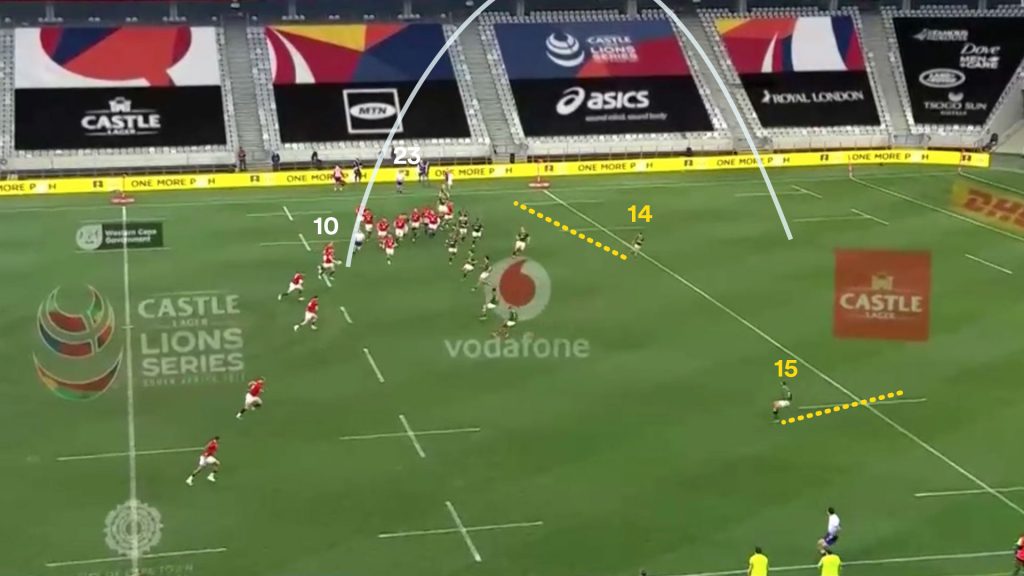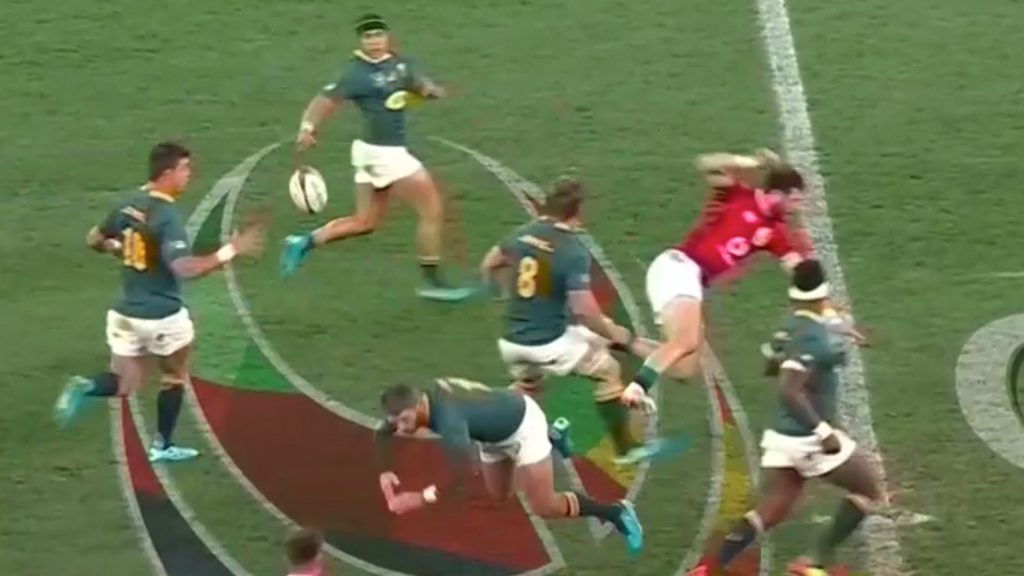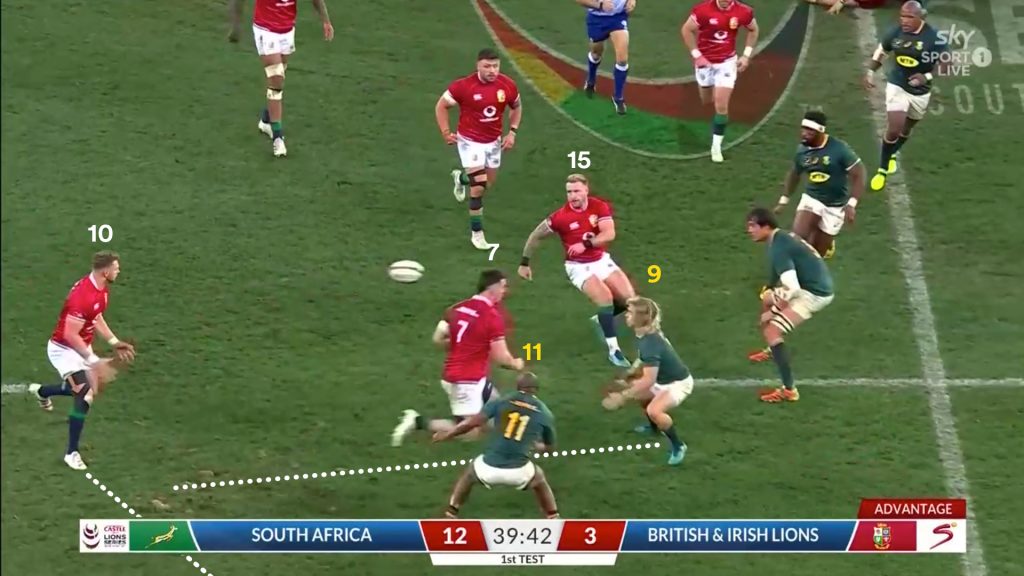In the lead-up to the Lions’ test series in South Africa, Warren Gatland and his staff tried many fly-halves throughout the warm-up games in search of their No1 option for the Springboks.
After starting against Japan at Murrayfield, Welsh No10 Dan Biggar stepped aside as Finn Russell and Owen Farrell took the next two starts. Biggar got the second repeat game against the Sharks before he was a late scratching for South Africa A, and Farrell assumed the role again.
When England’s Marcus Smith joined the camp, he was given a run against the Stormers. It wasn’t clear just who would be the preferred choice, but the selection of Biggar, who has been the form fly-half in the northern hemisphere this year, in the first test proved to be worthy, which completed a circuitous path to lead the Lions’ backline.
In 2019, Biggar was used as an experienced operator off the bench with Gareth Anscombe assuming the starting role for Wales. Despite this reduced role, Biggar often came up with a big play with a cool head or clutch kick late in games just when Wales needed him most, delivering heroic moments for Gatland.
That even-keel temperament was a much-needed asset for the Lions in the first test as Biggar showed composure under pressure, enterprise with the ball in hand and, critically, taking the key points on offer in the second-half comeback after missing an early shot at goal.
Having run many kick-pressure games at fly-half for Wales under Gatland, Biggar’s ability with the boot suited what the Lions were trying to do, and that was on show from the first play of the game.
From the first attacking set-piece launch, Biggar hoisted a massive Garryowen into the sky to keep the Springboks’ line speed honest. The early ploy almost paid off, when Duhan van der Merwe and Cheslin Kolbe jostled for the grab in the air before the ball spilled forward.


Biggar’s bomb complimented Ali Price’s box-kicking to continue the bombardment of the Springboks through the air. If it wasn’t Price, it was Biggar hoisting contestable kicks into the Cape Town night sky.
This was key to the Lions’ aerial assault, as 65 per cent of their kicks in the match were contestable balls compared to 54 per cent for the Springboks.
While Faf de Klerk was the main kicker for the Springboks, the Lions continued their raids with balance between No9 and No10.
With Conor Murray and Farrell coming in as replacements for the Lions, they ended up with a perfect 50-50 split with 11 kicks off the scrum-half and 11 off fly-half, after Price kicked eight times and Biggar seven.
When Biggar was on the field, all of his kicks were contestable or attacking, looking for possession to be regained. He was smart with his attacking kicks, only taking them under a penalty advantage.
A left-foot grubber into the space in behind the Springboks’ line was a deft piece of skill that continued to keep them honest, to try to turn the aggressive line speed against them early. Under advantage, it was a free play with little downside and resulted in the Springbok backfield spilling the ball.



The Lions found out how tough it would be to run plays against the Springboks backline when Biggar tried to find speedster Elliot Daly with early ball on the miss-pass.
As quick as the transfer was, Lukhanyo Am was even quicker, smashing the Lions centre almost on receipt of the ball.


The colossal hit resulted in a huge gain-line loss for the Lions and, under ruck pressure, they lost the ball as the Springboks piled in to flood the breakdown.
Am has proven to be the best defensive centre in world rugby, and the execution on this read showed why. The Lions went with a deep miss-pass to give Daly time, but Am took it away and subsequently created a turnover.
Daly, at centre, ultimately proved to be ineffective against the strong Springbok midfield. Despite possessing speed, he didn’t get a chance to show it as he continually lost ground in contact against the swarming defence. He didn’t get any time or space and the bold selection didn’t really pay off for Gatland.
England’s full-back wasn’t exactly in vintage touch before the Lions tour, and playing him at outside-centre seems to be bridge too far.
The Springboks outside-in edge defence is a cornerstone of their containment system, which looks to funnel play back inside at all costs. When Am shoots up, his wingers outside are tasked with the clean-up job, also rushing up to shut play down should the ball get past the centre.
Few have managed to unlock this edge defence, and while the Lions didn’t really crack it regularly in the first half, Biggar showed glimpses of majestic handling under pressure as he thrived against the high-pressure tactics.
In a passage under penalty advantage, Biggar was willing to chance his arm playing high-tempo rugby the same way twice to try to find a break out wide.

This pass on the second phase was straight out of the Matrix as Biggar triple-pumped the ball looking for an option as his outsides were cut-off by Am (13) and Makazole Mapimpi (11).
Delaying the release to ensure Am and Mapimpi were past him, Biggar thread the needle behind their backs, throwing a diving cut-out pass out wide to the free man Anthony Watson (14).




Even though Biggar gave Watson half a chance, the Springboks cover defence in Willie le Roux closed down taking away any opportunity. But Biggar once again found a way to get around the rush defence with late decisions and innovative thinking.
The Welsh fly-half continued to thrive under pressure on the outside, unfazed by the rush defence and delivering the ball despite the best efforts of South Africa’s outside backs to close on him.


The Springboks have proven that running league-style ‘overs-unders’ lines is not a great idea against them, but when Stuart Hogg (15) and Biggar (10) combined in reversed roles, they opened them up out wide for what must have been the first clean break on the Springboks’ edge in a long time.

Two key features of this play created this line break for Robbie Henshaw (12).
Tom Curry’s (7) unders line across De Klerk helped take out the inside support. De Klerk takes contact from Curry and goes down, perhaps trying to milk a penalty, but in the end leaves his side down a man on the inside.
In the zone and feeling the rush from Mapimpi, Biggar again moves the ball with fast hands, leaving the Springbok winger empty-handed, while the ball reaches the man in space.


Henshaw (12) is given a lane to rip through the line and only a great cover tackle by Le Roux (15) prevents the Lions from delivering a strike on the stroke of half-time.
Once again, influential work from Biggar was key, who stood calm in chaos and delivered quality ball to those outside him.
There was a sense of control by Biggar that Farrell and Russell at times have not shown, eliminating heart-in-mouth situations by playing error-free rugby based on sound decision-making, taking the risks when odds were stacked in his favour under advantage, while also showing exceptional skills when needed, like deft ball-playing short and long.
He manufactured their only clean line break, hit the crucial place kicks in the second half and kicked up-and-unders wisely to keep the Lions moving forward and pressure on the Springboks.
His clutch 63rd-minute penalty, five in from touch and 30metres out and that faded from left-to-right, gave the Lions a lead for the first time in the game at 19-17, part of his four from four in the second half that were absolutely critical in closing the gap and hitting the front, while at the other end Handre Pollard missed two costly kicks having hit four from four himself in the first half.
The way Daly was used at No13 just didn’t fit. At times he was asked to carry hard and make gain line but he didn’t have the power game to deliver. If that is what the Lions want from their outside-centre, Daly isn’t the man.
His only blemishes were two dropped high balls in the backfield and a tap-on pass that went forward in the first half but none of those hiccups cost his side unduly. When he was off the field for an HIA, his calming presence was missed when the Lions backs almost threw away the game if not for a Kolbe knock-on.
The panicked passing from the spilled ball almost gifted Damian de Allende a try, after Farrell decided not to catch a pass under pressure and the next man continued the cascading disaster by tapping it on.
If he can pass his return-to-play protocols after a bang to the side of the head from Siya Kolisi, Biggar will surely be the No10 when the Lions look to secure the series next weekend, but he could see changes outside him.
The way Daly was used at No13 just didn’t fit. At times he was asked to carry hard and make gain line but he didn’t have the power game to deliver. If that is what the Lions want from their outside-centre, Daly isn’t the man.
If the Lions want to explore a more expansive game around the 10-12 axis, elevating Farrell to No12 and pushing Henshaw to 13 could be the answer. Farrell is adept at playing the pull-back pass and Biggar showed he can handle blitz defenders out the back, beating the rush with fast hands and a sixth sense for pressure.
Henshaw, as a bigger-bodied centre, can provide the traditional ground game that they were after at 13. His height was also invaluable during kick-chases to compete in the air and pressure the South African catchers, so he is worth keeping on the field over Daly.
The Lions saved the series four years ago in New Zealand by rolling out their Johnny Sexton-Farrell combination in the second test, which was influential in crafting two tries in the last quarter to come back and win the game.
Now, a Biggar-Farrell version could seal a series in the second test if the Lions are prepared to push the chips on the table and make an aggressive tactical change to stay one step ahead of the Springboks.
Whatever happens, nothing will change that Biggar’s assured performance in the first test helped pave the way for a famous victory and now a possible series win in South Africa.
He did things that no one has been able to in structured play against this defensive system. And for that, he deserves more credit than what he is getting.
More analysis from Ben Smith
If you’ve enjoyed this article, please share it with friends or on social media. We rely solely on new subscribers to fund high-quality journalism and appreciate you sharing this so we can continue to grow, produce more quality content and support our writers.



Comments
Join free and tell us what you really think!
Sign up for free